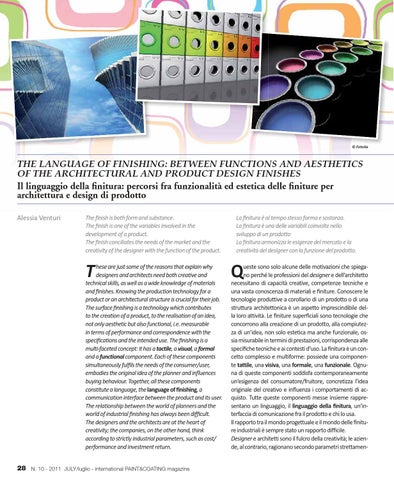© Fotolia
THE LANGUAGE OF FINISHING: BETWEEN FUNCTIONS AND AESTHETICS OF THE ARCHITECTURAL AND PRODUCT DESIGN FINISHES Il linguaggio della finitura: percorsi fra funzionalità ed estetica delle finiture per architettura e design di prodotto Alessia Venturi
The finish is both form and substance. The finish is one of the variables involved in the development of a product. The finish conciliates the needs of the market and the creativity of the designer with the function of the product.
T
hese are just some of the reasons that explain why designers and architects need both creative and technical skills, as well as a wide knowledge of materials and finishes. Knowing the production technology for a product or an architectural structure is crucial for their job. The surface finishing is a technology which contributes to the creation of a product, to the realisation of an idea, not only aesthetic but also functional, i.e. measurable in terms of performance and correspondence with the specifications and the intended use. The finishing is a multi-faceted concept: it has a tactile, a visual, a formal and a functional component. Each of these components simultaneously fulfils the needs of the consumer/user, embodies the original idea of the planner and influences buying behaviour. Together, all these components constitute a language, the language of finishing, a communication interface between the product and its user. The relationship between the world of planners and the world of industrial finishing has always been difficult. The designers and the architects are at the heart of creativity; the companies, on the other hand, think according to strictly industrial parameters, such as cost/ performance and investment return.
28 N. 10 - 2011 JULY/luglio - international PAINT&COATING magazine
La finitura è al tempo stesso forma e sostanza. La finitura è una delle variabili coinvolte nello sviluppo di un prodotto La finitura armonizza le esigenze del mercato e la creatività del designer con la funzione del prodotto.
Q
ueste sono solo alcune delle motivazioni che spiegano perché le professioni del designer e dell’architetto necessitano di capacità creative, competenze tecniche e una vasta conoscenza di materiali e finiture. Conoscere le tecnologie produttive a corollario di un prodotto o di una struttura architettonica è un aspetto imprescindibile della loro attività. Le finiture superficiali sono tecnologie che concorrono alla creazione di un prodotto, alla compiutezza di un’idea, non solo estetica ma anche funzionale, ossia misurabile in termini di prestazioni, corrispondenza alle specifiche tecniche e ai contesti d’uso. La finitura è un concetto complesso e multiforme: possiede una componente tattile, una visiva, una formale, una funzionale. Ognuna di queste componenti soddisfa contemporaneamente un’esigenza del consumatore/fruitore, concretizza l’idea originale del creativo e influenza i comportamenti di acquisto. Tutte queste componenti messe insieme rappresentano un linguaggio, il linguaggio della finitura, un’interfaccia di comunicazione fra il prodotto e chi lo usa. Il rapporto tra il mondo progettuale e il mondo delle finiture industriali è sempre stato un rapporto difficile. Designer e architetti sono il fulcro della creatività; le aziende, al contrario, ragionano secondo parametri strettamen-
